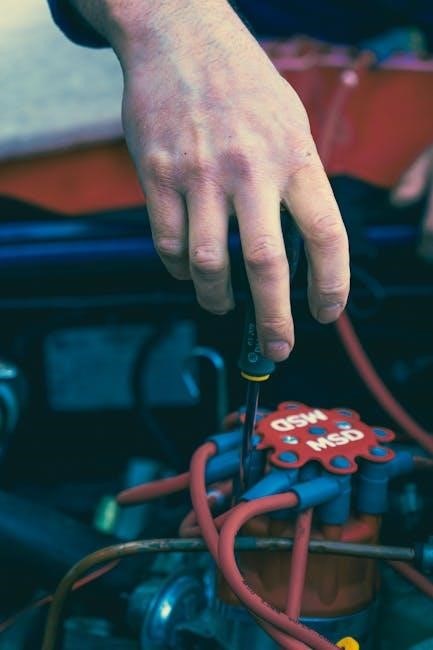Manual brakes rely on the driver’s muscle power, while power brakes use a booster for easier pedal pressure. This guide helps you choose the right system for your needs based on performance, maintenance, and cost considerations.

Understanding Brake Systems
Manual brakes use a master cylinder and manual effort, while power brakes employ a booster for added force. Both systems convert pedal input into friction to stop the vehicle effectively.
Manual Brake Components
Manual brake systems consist of a master cylinder, brake lines, calipers, brake pads, and a pedal linkage. The master cylinder converts non-hydraulic pedal pressure into hydraulic pressure. Brake lines distribute hydraulic fluid to the wheels. Calipers or wheel cylinders apply pressure to the brake pads or shoes, creating friction on the rotors or drums. Manual systems rely solely on the driver’s physical effort, with no power assistance. This simplicity reduces complexity but increases pedal force. The pedal and linkage system transfers the driver’s input to the master cylinder, initiating the braking process. Manual brakes are straightforward, with fewer components compared to power-assisted systems.
Power Brake Components
Power brake systems include a vacuum booster, master cylinder, brake lines, calipers, brake pads, and a pedal assembly. The vacuum booster amplifies pedal pressure using engine vacuum, reducing effort; The master cylinder converts this amplified pressure into hydraulic fluid flow; Brake lines distribute the fluid to calipers or wheel cylinders, applying the pads to the rotors or drums. A pressure sensor may be included for modern systems. The pedal assembly connects to the booster, initiating the process. Power brakes offer lighter pedal feel and faster response, enhancing overall braking performance and driver comfort. These components work together to provide reliable and efficient stopping power.

Functionality Comparison
Manual brakes rely on driver strength, requiring more pedal effort, while power brakes use a booster for easier, faster, and more responsive stopping, enhancing overall control and comfort.
How Manual Brakes Work
Manual brakes operate solely through mechanical linkages, relying on the driver’s physical effort. When the brake pedal is pressed, it directly activates the master cylinder, which sends brake fluid through the system to apply pressure on the brake pads or shoes. This pressure creates friction against the rotors or drums, slowing the vehicle. Without power assistance, manual brakes demand more force and pedal travel, especially in heavy vehicles or urgent stops. Proper setup and maintenance are crucial for consistent performance, as any mechanical failure can significantly reduce braking efficiency and safety. Regular inspections of components like brake lines and fluid levels are essential.
How Power Brakes Work
Power brakes use a brake booster to amplify the force applied to the pedal, reducing effort and improving control. When the pedal is pressed, the booster, often vacuum-assisted, multiplies the pressure before it reaches the master cylinder. This boosted force is then transmitted through brake fluid to the calipers or wheel cylinders, engaging the pads or shoes against the rotors or drums. The system relies on engine vacuum or an electric pump to provide assistance, making braking easier, especially in larger vehicles. This setup enhances stopping power and reduces driver fatigue, particularly in heavy traffic or frequent braking scenarios.

Pros and Cons
Manual brakes offer simplicity and reliability but require more effort, while power brakes provide easier control yet involve complex components and higher maintenance needs.
Advantages of Manual Brakes
Manual brakes are known for their simplicity and reliability, requiring less complex components compared to power brakes. This simplicity reduces the risk of mechanical failure and makes them easier to maintain. They are also lighter and more cost-effective, as they don’t require a vacuum booster or additional hardware. Additionally, manual brakes provide better pedal feel, giving drivers more control over braking force. This direct connection to the brake system can be advantageous in situations where precise modulation is needed. Overall, manual brakes are a practical choice for drivers seeking a straightforward, low-maintenance braking solution.
Disadvantages of Manual Brakes
Manual brakes require significantly more pedal effort, making them less comfortable, especially in heavy traffic or frequent stop-and-go situations. This increased effort can lead to driver fatigue and strain, particularly for those with physical limitations. Additionally, manual brakes often lack the precise modulation and responsiveness offered by power-assisted systems, which can be a disadvantage in emergency braking scenarios. The pedal travel is also typically longer, requiring more time to engage fully, and they may not perform as effectively in larger or heavier vehicles. These drawbacks make manual brakes less ideal for modern driving conditions where ease and efficiency are prioritized.
Advantages of Power Brakes
Power brakes offer significant advantages, primarily in reduced pedal effort and enhanced braking performance. They utilize a booster to amplify the force applied to the brake pedal, making braking easier and less physically demanding. This is particularly beneficial for drivers with limited strength or endurance. Power brakes also provide shorter stopping distances in emergency situations, improving overall safety. Additionally, they deliver a more consistent and responsive braking experience, especially in modern vehicles with advanced safety systems. The reduced fatigue and improved control make power brakes a preferred choice for everyday driving, particularly in heavy traffic or hilly terrain where frequent braking is necessary.
Disadvantages of Power Brakes
Power brakes have several drawbacks that may make them less ideal for certain drivers. The system relies on engine vacuum or an electric pump, which can fail, leading to a loss of assist and increased pedal effort. This dependency on auxiliary systems makes power brakes less reliable in situations where engine power is lost. Additionally, the components are more complex and expensive to maintain or replace compared to manual brakes. The cost of repairs and the potential for mechanical failure can be a significant downside for budget-conscious drivers seeking simplicity and durability in their braking system.

Maintenance and Reliability
Manual brakes are simpler and more reliable due to fewer components, while power brakes require regular maintenance of the booster and vacuum system, which can fail over time.
Maintenance Requirements for Manual Brakes
Manual brakes require regular inspection of brake fluid levels and master cylinder condition to prevent leaks. Brake pads and rotors should be checked for wear, and replaced when necessary. Brake lines must be inspected for damage or corrosion, and cleaned to ensure proper function. The mechanical linkage connecting the pedal to the brakes should be maintained to avoid spongy pedal feel. Regular cleaning of the entire system is essential to prevent dirt buildup. Overall, manual brakes are simpler, with fewer components to maintain, making them more reliable in the long term compared to power-assisted systems.
Maintenance Requirements for Power Brakes
Power brakes require regular inspection of the vacuum booster and its connections to ensure proper pressure. The brake fluid level should be checked and topped off as needed. The master cylinder and power booster must be maintained to prevent leaks or fluid contamination. The vacuum pump, if equipped, should be inspected for wear and replaced if necessary. Brake pads and rotors need to be monitored for wear consistent with manual brakes. Regular cleaning of the entire system is essential to prevent dirt buildup. Additionally, the electrical connections for the vacuum pump and other components should be inspected for integrity. Proper maintenance ensures reliable operation and consistent braking performance.

Cost Considerations
Manual brakes are generally more cost-effective upfront, while power brakes may offer long-term savings through reduced wear and lower maintenance needs over time.
Cost of Manual Brake Systems
Manual brake systems are typically more affordable upfront, as they lack the additional components like vacuum boosters found in power brakes. However, their lower cost is offset by higher maintenance needs. Over time, manual brakes may require more frequent replacements of components such as master cylinders, brake lines, and pads due to increased wear from constant pedal pressure. Additionally, labor costs for repairs can add up, especially if the system is complex or less common. While the initial investment is lower, manual brakes may not be the most cost-effective option in the long run, particularly for drivers seeking durability and ease of use.
Cost of Power Brake Systems
Power brake systems are generally more expensive than manual brakes due to the inclusion of advanced components like vacuum boosters and servo-assisted units. These systems require a higher initial investment, as the booster and additional hardware increase the overall cost. However, they offer long-term benefits such as reduced maintenance and lower wear on brake components. The enhanced braking performance and ease of use can also lead to fewer repairs over time, making power brakes a cost-effective choice for drivers prioritizing convenience and reliability. Despite the higher upfront cost, the benefits often justify the expense for many vehicle owners. Efficiency and durability are key factors.

Driving Scenarios
Manual brakes require more effort, making them less ideal for city driving, while power brakes offer easier control in heavy traffic and emergency stops, enhancing safety and convenience.
Manual Brakes in City Driving
Manual brakes in city driving require more effort and attention, as frequent stops and starts demand constant pedal pressure. This can lead to increased leg fatigue, especially in heavy traffic; Without power assistance, manual brakes rely solely on the driver’s strength, making them less convenient for urban environments. However, some drivers prefer the direct control manual brakes provide, allowing for precise modulation. In stop-and-go scenarios, manual brakes can feel less responsive, potentially leading to slower reaction times. Despite this, proper setup and maintenance can enhance their performance, making them a viable option for city driving for those who value simplicity and mechanical feedback.
Power Brakes in City Driving
Power brakes excel in city driving due to their reduced pedal effort, making frequent stops less tiring. The booster amplifies braking force, allowing for quicker and more controlled deceleration in traffic. This system is particularly advantageous in urban environments, where sudden stops are common. Power brakes provide a smoother driving experience, reducing driver fatigue and enhancing safety. Their responsiveness is consistent, even in heavy traffic, making them ideal for city conditions. However, reliance on engine vacuum or electronic assist means any system failure could compromise braking efficiency, highlighting the importance of regular maintenance for optimal performance in urban settings.
